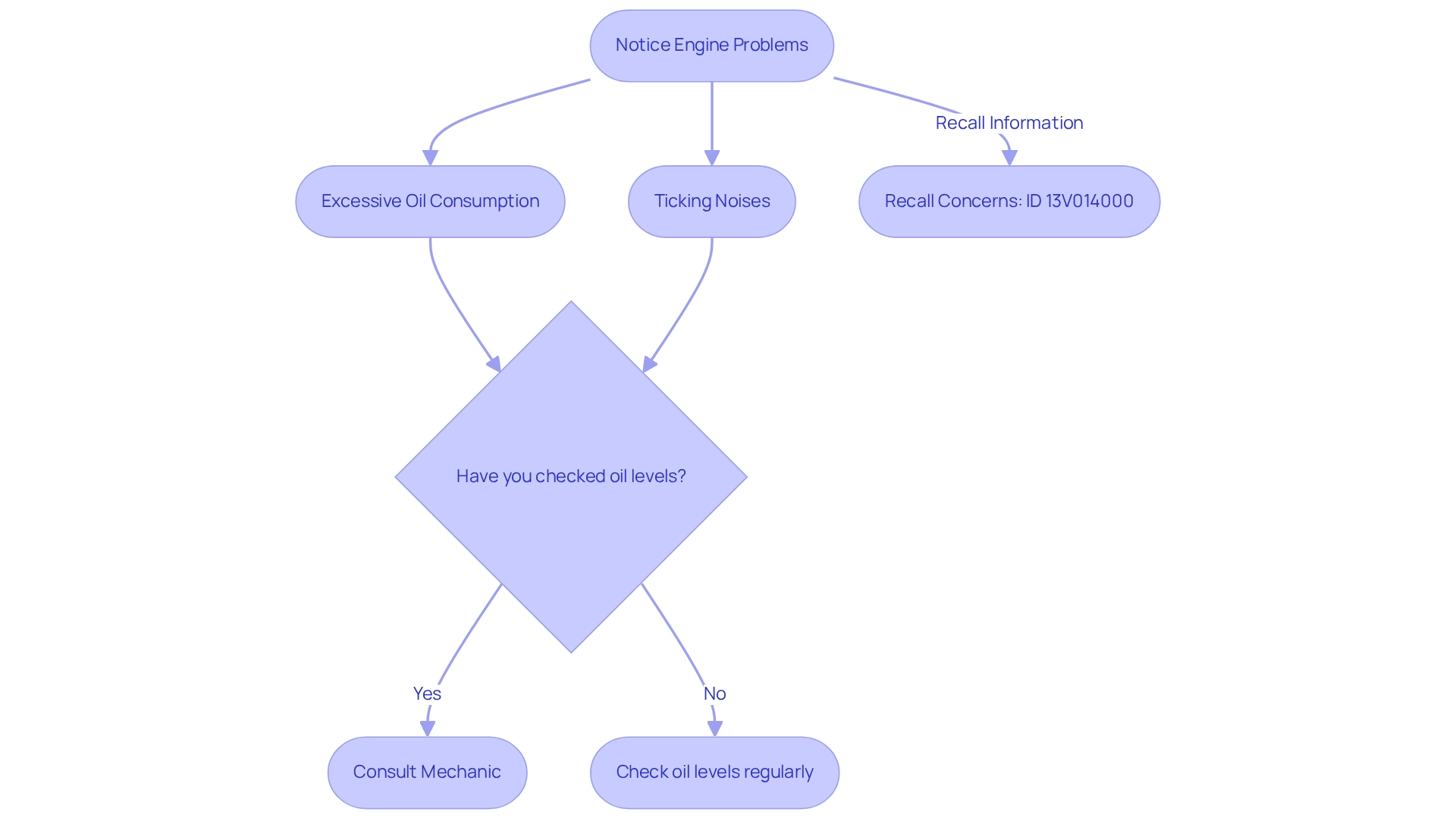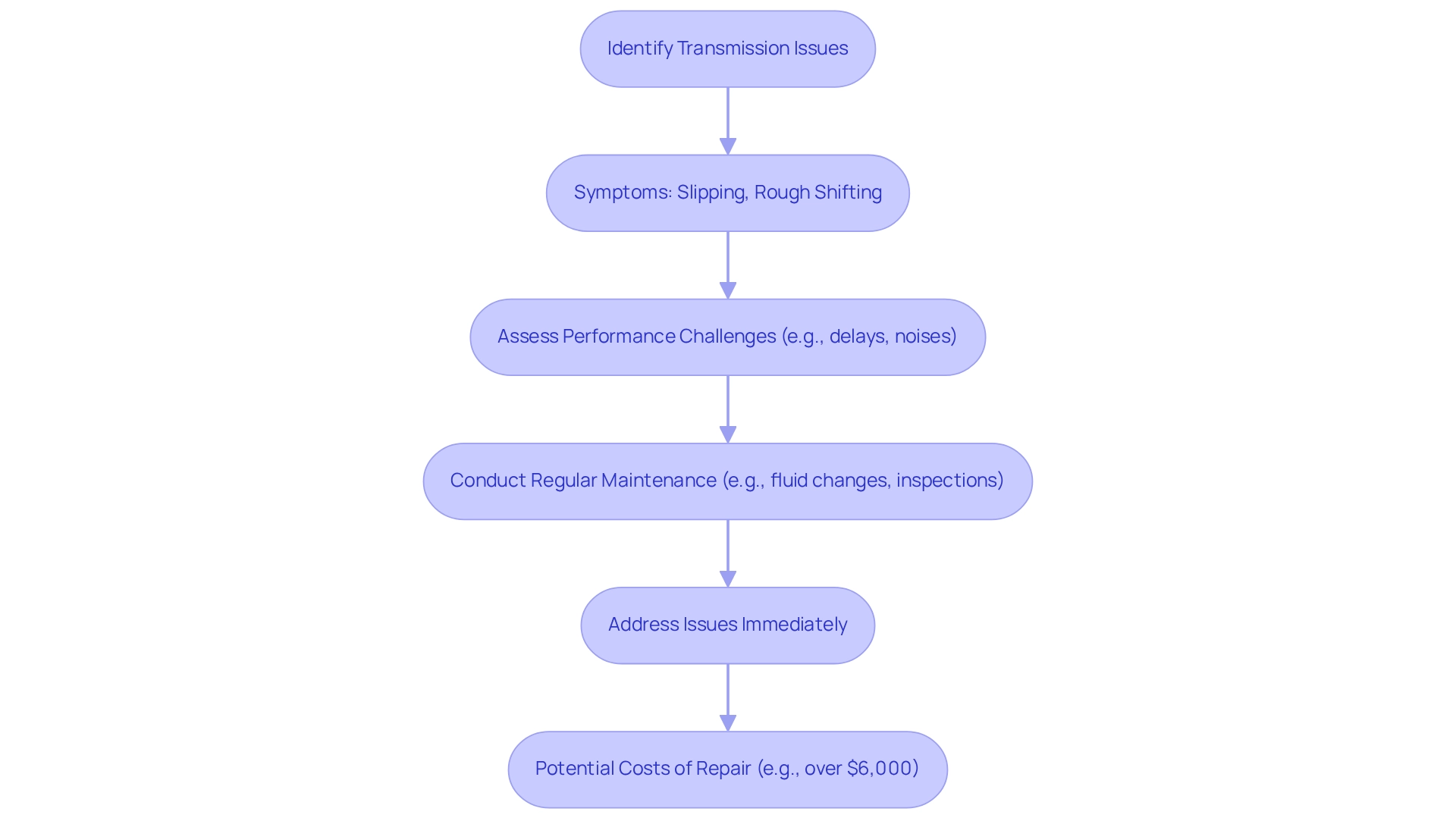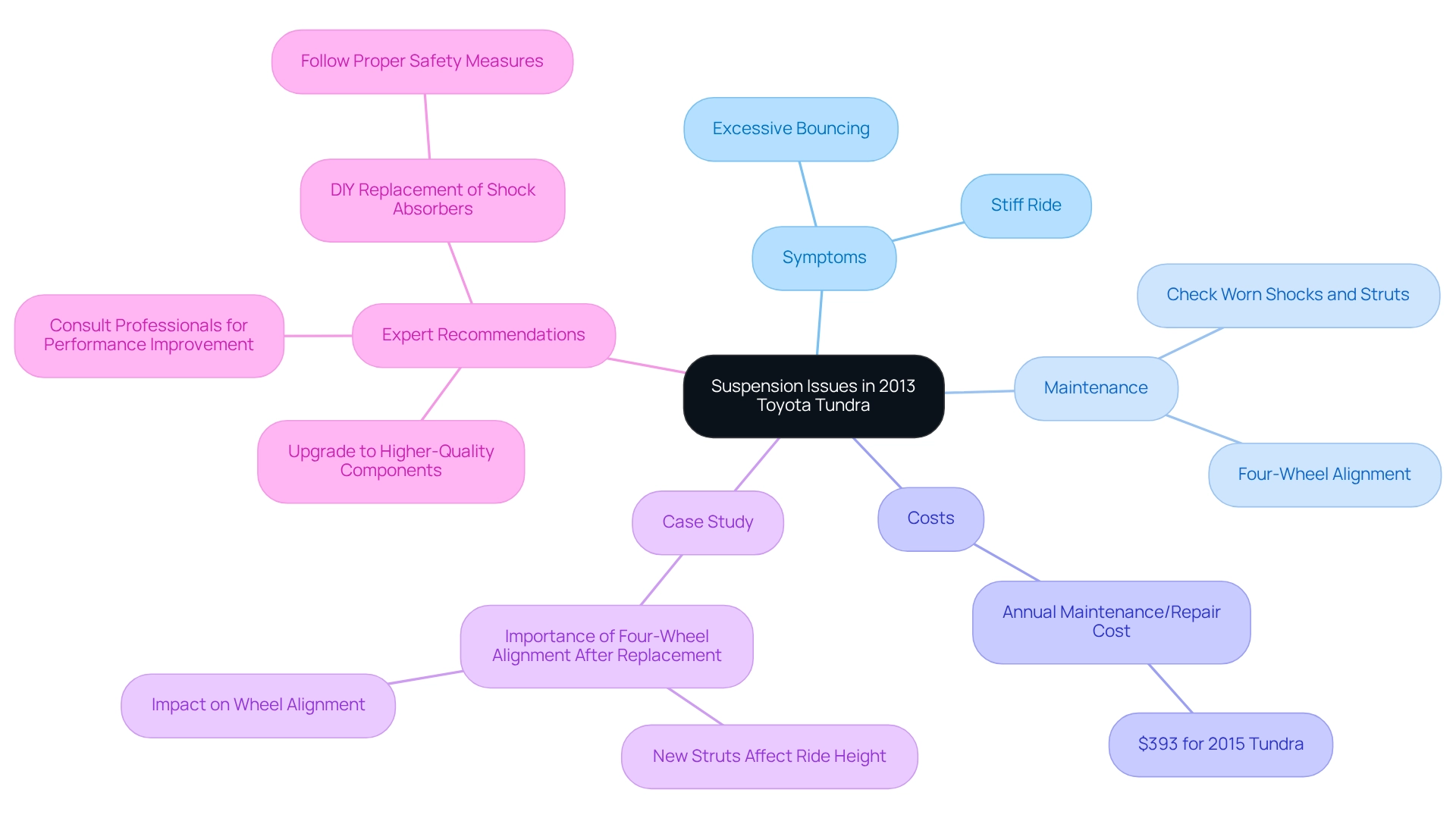5 Common 2013 Toyota Tundra Issues Every Owner Should Know

Overview
This article provides an overview of five common issues that owners of the 2013 Toyota Tundra may encounter. These include:
- Engine problems
- Transmission failures
- Electrical system malfunctions
- Brake issues
- Suspension concerns
Understanding these features is crucial, as they can significantly impact the vehicle’s performance.
Addressing these problems promptly offers several advantages. Regular maintenance and vigilance in monitoring these issues can prevent costly repairs down the line. This proactive approach not only saves money but also ensures the vehicle’s reliability over time.
Have you ever considered how regular upkeep can extend the life of your Tundra? By being aware of these potential concerns, owners can take the necessary steps to mitigate risks and enhance their driving experience. In conclusion, staying informed about these common issues is essential for maintaining the Tundra’s performance and reliability.
Introduction
The 2013 Toyota Tundra is recognized for its rugged reliability, but it does face some engine troubles and mechanical quirks. As owners reach the 70,000-mile mark and beyond, they may encounter issues such as:
- Excessive oil consumption
- Transmission slip
- Electrical system failures
These problems can raise concerns among drivers. Additionally, brake complications can compromise safety, while suspension stiffness may disrupt comfort. Therefore, the Tundra’s performance can falter if not closely monitored.
This article explores the most common problems faced by Tundra owners, emphasizing the importance of regular maintenance and proactive measures. Understanding these challenges is vital for owners who wish to maintain their vehicle’s performance and safeguard against costly repairs. By addressing these issues, Tundra owners can ensure the longevity and reliability of this popular pickup truck.
Top5: Engine Problems in 2013 Toyota Tundra
The 2013 Toyota Tundra issues have garnered attention for several notable engine-related problems, particularly excessive oil consumption and ticking noises emanating from the exhaust manifold. These problems typically manifest around 74,000 miles, posing a risk of engine failure if not addressed in a timely manner. Regular maintenance and diligent monitoring of oil levels are crucial in mitigating these risks. Additionally, certain individuals have reported complications with the air injection pump, which can result in substantial repair expenses if not identified promptly. Vehicle owners must remain vigilant and seek professional advice from a mechanic upon noticing any unusual sounds or declines in performance.
In addition to these engine concerns, it’s important to note the recall ID 13V014000 issued on January 16, 2013, for a faulty occupant sensing system calibration, which increases the risk of injury in crashes. Expert opinions emphasize that while this vehicle maintains a reputation for reliability, awareness of the 2013 Toyota Tundra issues is vital. Mechanics have noted that excessive oil consumption is a common concern related to 2013 Toyota Tundra issues, with some attributing it to design flaws in the engine. Despite these challenges, case studies indicate that the 2013 model continues to be viewed as a dependable option within its class, competing effectively with other full-size pickups. The findings from the ‘2013 Toyota Overall Reliability Assessment’ indicate that although there are grievances and recalls, the vehicle’s reputation for dependability remains intact. Owners are encouraged to remain informed about these potential concerns to ensure their vehicle’s longevity and performance. To effectively monitor your vehicle, regularly check oil levels and consult a mechanic if you notice any unusual sounds or performance declines.

Transmission Failures in 2013 Toyota Tundra
The 2013 Toyota Tundra issues often include transmission problems that present as slipping or rough shifting, particularly noticeable after reaching approximately 100,000 miles. The 2013 Toyota Tundra issues can lead to significant performance challenges, such as delays in acceleration and unusual noises during shifting. For example, one user reported a clunking noise in their 2011 truck’s front end when engaging 4WD, raising concerns about the reliability of the 4WD system.
To mitigate these risks, regular transmission fluid changes and thorough inspections are essential. Mechanics strongly recommend addressing any signs of trouble immediately. Repair costs can escalate quickly, with estimates for complete transmission replacements exceeding $6,000. Notably, a 2000 model with 133,000 miles experienced total transmission failure, underscoring potential durability concerns.
As Fremont Foreign Auto states, “You bought an Acura TLX because you wanted luxury, performance, and reliability—but even the best-engineered cars develop issues over time.” Early detection and proactive maintenance are crucial for avoiding costly repairs and ensuring the longevity of your vehicle. Furthermore, a 2008 pickup owner discovered that a mouse nest caused wiring damage, adversely affecting the vehicle’s transmission performance. This highlights the necessity of routine inspections to maintain optimal function.

Electrical System Malfunctions in 2013 Toyota Tundra
Owners frequently report electrical issues with the 2013 Toyota Tundra, particularly concerning the alternator and dashboard lights. A prevalent issue is the failure of instrument panel lights, which compromises visibility regarding vehicle performance. Additionally, many users encounter problems with the battery and starter, often requiring replacements. Regular evaluations of the electrical system, including battery condition and wiring integrity, are essential to avoid these complications.
For instance, a notable case involved an owner whose dashboard lights flickered, indicating potential wiring issues. The complexity of the electrical network is underscored by the presence of 16 computers in the truck managing various functions, which can increase the likelihood of malfunctions. If you experience flickering lights or difficulty starting your vehicle, it is advisable to consult a professional for a thorough diagnosis.
Statistics reveal that electrical system failures are among the most common complaints related to 2013 Toyota Tundra issues, highlighting the importance of proactive maintenance. A case study pointed out a design flaw that permits rodents to enter the cab and chew on wiring, leading to potential malfunctions. Furthermore, Duarte, a vehicle owner, remarked, “The turn signal ceased functioning; I activated the emergency lights, and the flasher relay produces a buzzing noise.” This personal narrative illustrates the practical electrical challenges faced by owners.
Finally, for individuals dealing with electrical problems, understanding the auxiliary fuse arrangement can be beneficial. This is exemplified by a request from a 2011 Toyota vehicle operator for a highlighted diagram of the auxiliary fuse in the fuse box.

Brake Problems in 2013 Toyota Tundra
The 2013 Toyota Tundra issues frequently include brake problems, especially concerning premature wear of pads and rotors, as well as complications with the antilock braking system. Many drivers experience significant pulsation or vibration while braking, which frequently indicates warped rotors. This condition can arise from factors such as heat buildup, the quality of rotor materials, or driving habits. Regular inspections and timely replacements of worn components are essential for ensuring optimal braking performance.
Statistics indicate that premature brake pad wear is a common complaint among Tundra owners, especially regarding 2013 Toyota Tundra issues, highlighting the necessity for proactive maintenance. Have you noticed a soft brake pedal or heard unusual noises while braking? Immediate inspection is crucial to prevent potential brake failure. Mechanics emphasize that maintaining the integrity of the brake system is vital for safe driving.
As noted by Brakes 4 Less, “If necessary, we’ll replace the affected lines with durable materials to maintain your brake system’s safety and reliability.” Addressing these issues promptly can significantly enhance your vehicle’s reliability on the road. A case study on 2013 Toyota Tundra issues related to warped rotors illustrates that many owners report a pulsating sensation when braking, often attributed to these warped rotors. Brakes 4 Less provides premium replacement rotors and professional installation, ensuring that your vehicle maintains optimal braking performance regardless of road challenges.

Suspension Issues in 2013 Toyota Tundra
Issues related to the suspension in the 2013 Toyota Tundra are frequently reported, especially regarding the rear suspension. This issue can lead to excessive bouncing and a stiff ride. Many owners have noted that the suspension feels overly rigid, especially when the vehicle is loaded, resulting in discomfort during travel. Regular maintenance is crucial; checking for worn shocks and struts can significantly improve ride quality. If drivers experience a noticeable decline in comfort or hear unusual noises when traversing bumps, it is essential to have the suspension system professionally evaluated.
Statistics indicate that the average annual maintenance and repair cost for the 2015 Tundra is approximately $393. While this figure acts as a standard, it’s essential to recognize that maintenance expenses can differ depending on the model year and particular concerns. Addressing these issues promptly can prevent more extensive damage and higher costs down the line.
A case study highlights the importance of performing a four-wheel alignment after replacing suspension struts. New struts can alter ride height and affect wheel alignment. This adjustment is vital for ensuring proper vehicle handling and minimizing tire wear. As noted by RepairPal, “the vehicle needs to be safely lifted and supported off the ground to complete this repair.”
In 2025, reports continue to emerge about 2013 Toyota Tundra issues, particularly concerning rear suspension, highlighting the necessity for continued alertness among users. Expert insights suggest that improving suspension performance may involve upgrading to higher-quality components or adjusting the existing setup to better accommodate load conditions. Additionally, shock absorbers are typically easier and safer for DIY mechanics to replace if proper safety measures are followed. By staying proactive about maintenance and repairs, Tundra owners can enhance their driving experience and extend the lifespan of their vehicle’s suspension system. For those looking to improve suspension performance, consider consulting with a professional or researching aftermarket options that suit your driving needs.

Conclusion
The 2013 Toyota Tundra is well-regarded for its reliability, yet it presents several challenges that owners must navigate as their vehicles age. Notable issues include:
- Excessive oil consumption
- Transmission failures
- Electrical system malfunctions
- Brake complications
- Suspension stiffness
Each of these problems can significantly impact performance and safety, making it essential for owners to stay vigilant.
Regular maintenance and prompt attention to any signs of trouble are crucial for mitigating these risks. Checking oil levels, inspecting the transmission, and monitoring electrical systems and brake components are proactive measures that can help prevent costly repairs. By understanding the common issues faced by Tundra owners, individuals can prepare for potential challenges and take necessary steps to maintain their vehicle’s integrity.
Ultimately, the longevity and performance of the 2013 Toyota Tundra depend on the owner’s commitment to regular maintenance and awareness of these common problems. By addressing these issues proactively and seeking professional advice when needed, Tundra owners can continue to enjoy the rugged reliability that this iconic pickup truck is known for, ensuring it serves them well for many miles to come.
Frequently Asked Questions
What are the main engine-related issues reported for the 2013 Toyota Tundra?
The main engine-related issues include excessive oil consumption and ticking noises from the exhaust manifold, which typically manifest around 74,000 miles and can lead to engine failure if not addressed.
What should vehicle owners do to mitigate the risks of engine problems in the 2013 Toyota Tundra?
Vehicle owners should perform regular maintenance, diligently monitor oil levels, and seek professional advice from a mechanic if they notice any unusual sounds or declines in performance.
What is the significance of recall ID 13V014000 for the 2013 Toyota Tundra?
Recall ID 13V014000, issued on January 16, 2013, pertains to a faulty occupant sensing system calibration, which increases the risk of injury in crashes.
Are there any design flaws associated with the 2013 Toyota Tundra’s engine?
Yes, excessive oil consumption has been attributed to design flaws in the engine, according to some mechanics.
How does the 2013 Toyota Tundra rank in terms of reliability despite these issues?
Despite the reported issues and recalls, the 2013 Toyota Tundra continues to be viewed as a dependable option within its class, competing effectively with other full-size pickups.
What transmission problems are commonly reported for the 2013 Toyota Tundra?
Common transmission problems include slipping or rough shifting, particularly after reaching approximately 100,000 miles, which can lead to delays in acceleration and unusual noises during shifting.
What maintenance practices can help prevent transmission issues in the 2013 Toyota Tundra?
Regular transmission fluid changes and thorough inspections are essential to mitigate transmission issues.
What are the potential costs associated with transmission repairs for the 2013 Toyota Tundra?
Repair costs for transmission issues can escalate quickly, with estimates for complete transmission replacements exceeding $6,000.
What unusual factors can affect the transmission performance of the 2013 Toyota Tundra?
An example includes a case where a mouse nest caused wiring damage, adversely affecting the vehicle’s transmission performance, highlighting the necessity of routine inspections.





